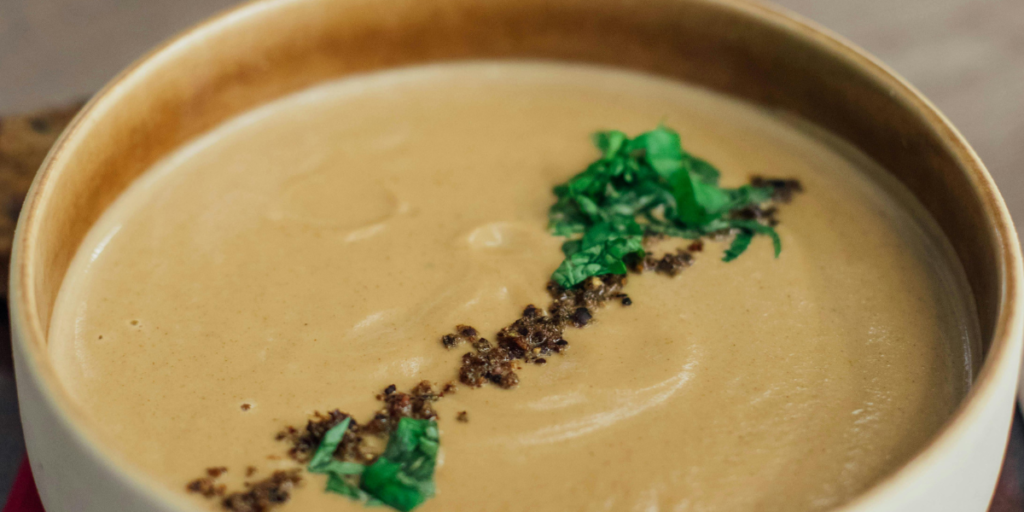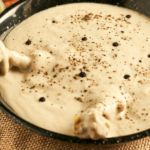Trahana Recipe – Traditional Dish

Wondering what Trahana is, what it is made of & how to prepare it?
If, yes, then you’re in the right place. Today, I’ll share everything you need to know about this unique dish, so make sure to read all the steps to ensure a delicious meal.
If you’re interested in exploring more Albanian recipes, you might also want to check out this Albanian Cornbread Recipe for a delightful accompaniment or this Albanian Flija Recipe for another traditional Albanian dish.
Now let’s jump into the recipes.
What Is Trahana?
Trahana is a traditional Mediterranean and Middle Eastern food product that can be described as a type of grain-based pasta or dried dough.
What Is The History Of Tarhana?

The history of trahana is a fascinating journey that traces back to ancient Mediterranean and Middle Eastern civilizations.
With origins dating over a thousand years ago, trahana emerged as a preservation method for surplus grains and dairy, enabling communities to endure challenging climates.
Its nutritional value, extended shelf life, and versatility made it a vital food source in antiquity. Over time, regional variations emerged, incorporating diverse ingredients like vegetables and meat.
Today, trahana remains a cherished culinary tradition, symbolizing cultural heritage.
Modern adaptations, both homemade and commercial, continue to honor this ancient food product, connecting contemporary tastes with the enduring flavors of the past.
What Is Trahana Made From?

Trahana is made from a mixture of two primary ingredients: grain and yogurt or fermented milk.
The specific grains used in trahana can vary, but they are often wheat or bulgur.
The process of making trahana involves combining these grains with yogurt or fermented milk to create a dough-like mixture.
What Does Trahana Taste Like?
Trahana tastes like a tangy, creamy, and slightly sour flavor profile, which results from the fermentation process involving yogurt or fermented milk.
It offers a subtle savory quality and may have hints of earthiness or nuttiness.
This Mediterranean and Middle Eastern ingredient adds depth and complexity to dishes, making it a valuable culinary component for soups, stews, and side dishes.
How Can You Make Trahana?
Making trahana at home is a delightful culinary endeavor.
To craft this unique Mediterranean staple, combine 2 cups of wheat semolina or bulgur with 2 cups of yogurt and 1 cup of water.
Stir until you achieve a dough-like consistency, seasoning it with salt to your liking. Cover the mixture and let it ferment at room temperature for approximately 24 hours, occasionally stirring.
After fermentation, the mixture will emit a tangy aroma and possess a slightly sour taste. Break it into small pieces or granules, then proceed to dry them thoroughly.
Once dried, store your homemade trahana in an airtight container, ready to enhance a variety of dishes, from soups to stews.
Is Trahana Healthy?
Yes, Trahana can be a healthy food choice, depending on how it’s prepared and consumed. Here are some factors to consider:
- Nutritional Value: Trahana is made from a mixture of grain and yogurt or fermented milk, which provides essential nutrients like carbohydrates, protein, and calcium.
- Probiotics: The fermentation process involved in making Trahana introduces beneficial probiotics, which can promote gut health and aid digestion.
- High Fiber: Trahana is a good source of dietary fiber, which can help with satiety and digestive health.
- Low Fat: Traditionally, Trahana is made with low-fat yogurt or milk, making it a low-fat food option.
- Versatility: Trahana can be used in various dishes, including soups and stews, allowing for a balanced and nutritious meal when combined with other ingredients like vegetables and lean protein.
Where Can You Buy Sour Trahana?
You can find sour Trahana in various places, with Amazon being a convenient option for online shopping. Here’s a revised list:
- Amazon: Online retailers like Amazon often offer a wide selection of sour Trahana, making it easily accessible for online shoppers.
- Mediterranean and Middle Eastern Grocery Stores: Local stores specializing in Mediterranean and Middle Eastern foods may carry sour Trahana. Check with these stores in your area.
- Specialty Food Markets: Some specialty food markets or gourmet stores may stock sour Trahana or other Trahana variations.
- Local Producers: In regions with a strong Mediterranean or Middle Eastern presence, you might find local producers who make and sell Trahana directly to consumers.
What Is The Difference Between Sweet And Sour Trahana?
The difference between sweet and sour Trahana lies primarily in their flavor profiles and culinary uses. Sour Trahana is characterized by its tangy and slightly sour taste, a result of the fermentation process involving yogurt or fermented milk.
This sourness makes it ideal for savory dishes, enhancing soups, stews, and side dishes with its unique tangy and creamy quality.
On the other hand, sweet Trahana is made without the sour fermentation step, resulting in a milder, neutral flavor.
It is typically reserved for sweet recipes, adding depth to desserts, breakfast options, and sweet pastries. These two variations of Trahana cater to a wide array of culinary possibilities in Mediterranean and Middle Eastern cuisines.
Is Trahana Fermented?
Yes, Trahana is indeed fermented as part of its traditional preparation process.
The fermentation of Trahana involves mixing grains (commonly wheat or bulgur) with yogurt or fermented milk.
During this fermentation period, the beneficial bacteria naturally present in the yogurt or milk initiate the fermentation process, leading to the development of a sour flavor and a transformation of the mixture’s texture.
After the fermentation process, Trahana is typically dried and can be stored for extended periods while retaining its flavor and nutritional value.
Does Tarhana Have Gluten?
Yes, Tarhana typically contains gluten.
The main ingredient in Tarhana is wheat or bulgur, both of which are grains that naturally contain gluten. Gluten is a protein found in certain grains like wheat, barley, and rye.
Therefore, if you have gluten sensitivity or celiac disease, it’s essential to be cautious when consuming Tarhana or choose gluten-free alternatives made with non-gluten grains.
What Is Trahana Good For?
Trahana is good for both culinary versatility and potential health benefits.
This traditional Mediterranean and Middle Eastern ingredient is nutrient-rich, providing carbohydrates, proteins, and essential nutrients like calcium and B vitamins.
Its fermentation process introduces probiotics, supporting gut health and digestion. Trahana’s high fiber content promotes satiety, making it a satisfying addition to meals.
Can Trahana Go Bad?
Yes, trahana can go bad. But, like many dried food products, has a long shelf life and is less prone to spoilage compared to fresh foods.
However, it can still go bad or become spoiled if not stored properly or exposed to moisture. Here are some factors to consider:
- Moisture: Trahana should be kept in an airtight container in a dry, cool place. Exposure to moisture can cause it to become moldy or develop an off smell.
- Storage Conditions: Proper storage is crucial. If stored in a humid or warm environment, Trahana is more likely to spoil. Keep it in a cool, dark place away from direct sunlight.
- Expiration Date: Commercially packaged Trahana may have an expiration date. It’s advisable to check for this date and consume it before or around that time for the best quality.
- Odor and Appearance: Inspect Trahana for any signs of unusual odor, discoloration, or the presence of mold. If you notice any of these, it’s best to discard it.
While Trahana has good keeping qualities, it’s essential to store it properly and use your senses to determine its freshness to ensure you’re consuming it safely.
Is Trahana Good For Weight Loss?
Yes, Trahana can be a part of a weight loss-friendly diet when consumed in moderation and as part of a well-balanced meal plan. Here are some factors to consider:
- Fiber Content: Trahana is a good source of dietary fiber, which can help increase feelings of fullness and reduce overall calorie intake.
- Protein: It contains protein, which is important for maintaining muscle mass and promoting satiety.
- Versatility: Trahana can be used in various dishes, including soups and stews, where it can enhance flavor and make meals more satisfying.
- Portion Control: While Trahana can be a nutritious addition to a diet, it’s important to consume it in appropriate portion sizes to manage calorie intake.
Conclusion
In conclusion, Trahana is a versatile and ancient food product with a rich history.
It offers unique flavors and nutritional benefits, whether it’s the tangy sour Trahana for savory dishes or the neutral sweet Trahana for desserts.
Its ability to adapt to various recipes showcases its significance in Mediterranean and Middle Eastern cuisines.
Exploring these Trahana variations allows us to appreciate the diverse culinary traditions and the enduring flavors that connect us to the past.
Trahana Recipe
Ingredients
- 1 cup sour Trahana
- 4 cups water or vegetable broth
- 1 onion finely chopped
- 2 cloves garlic minced
- 2 tablespoons olive oil
- 1 teaspoon dried mint
- Salt and pepper to taste
- Optional: Crumbled feta cheese and fresh mint leaves for garnish
Instructions
- In a large pot, heat the olive oil over medium heat. Add the chopped onion and sauté until it becomes translucent.
- Add the minced garlic and continue sautéing for another minute until fragrant.
- Stir in the sour Trahana and cook for a few minutes, allowing it to lightly toast.
- Pour in the water or vegetable broth and bring the mixture to a boil.
- Reduce the heat to a simmer, cover the pot, and let it cook for about 15-20 minutes or until the Trahana is tender, stirring occasionally.
- Season the soup with salt, pepper, and dried mint. Adjust the seasoning to your taste.
- Serve hot, garnished with crumbled feta cheese and fresh mint leaves if desired.

